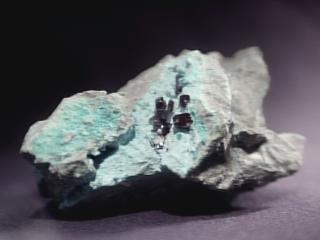
CUPRITE
Specimen cup-13
$ 115.00
Dims: 4.2" x 2.7" x 2.0" (10.7 x 6.9 x 5.1 cm)
Wt: 11.4 oz. (323 g)
Mashamba Mine, Shaba, Zaire
At least 10 octahedral Cuprite crystals rest in a shallow, plancheite-lined hollow in the host rock of this specimen. They are in excellent condition, showing no human-induced damage, and range from less than 1 mm to over 0.2" (0.5 cm) in any dimension. Their form is slightly warped but very good, showing well-defined edges and smooth faces that have a bright, nearly metallic luster. Their color is a deep red, but that luster makes them appear almost gray in some instances. They show definite translucence in bright light, and one or two of the smaller crystals show transparence through light reflected off of a few small internal fractures.
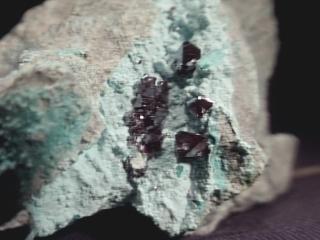
 Amethyst Galleries' Mineral Gallery MINERALS |
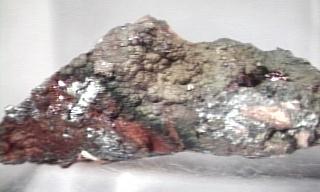
CUPRITE specimen cup-1
$ 200.00
$ 200.00
Dims: 5"x1-1/2"x1-1/2"
Wt: 5.2 oz
Ray Mine, Kearney, Arizona
Deep red with a metallic to adamantine luster is the best way to describe the main attraction of this specimen. Resting on a bed of botryoidal Goethite are Cuprite crystals that measure up to 1/8 inch in diameter. The best crystals are huddled up in a tiny vug that offers them considerable protection. There are, however, small clusters of semi-crystalline masses or partly-crushed crystals scattered elsewhere on the specimen. The Goethite matrix turns from a blackish crust to a red-brown mass that looks a bit like a funky wood. It's a really neat rock!

cup-1 ($200.00)
Ray Mine, Kearney, Arizona

CUPRITE specimen cup-2
$ 90.00
$ 90.00
Dims: 1.5" x 1.5" x 1"
Wt: 1.2 oz.w/ base
Ray Mine, Kearney, Arizona
Though this is a small specimen, the Cuprite crystals that it has to offer are easy to see. The deep red cubes are unmistakable, and their high luster helps you catch sight of them instantly against even a dark Goethite background. The crystals are, for the most part, flattened against the matrix (although one small cube is perfect). Additionally, there are areas of crusts (lighter red in the images) that, under 15x magnification, are built from branching trees of little tiny Cuprite cubes!

cup-2 ($ 90.00)
Ray Mine, Kearney, Arizona
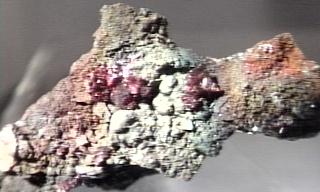
CUPRITE specimen cup-3
$ 150.00
$ 150.00
Dims: 2" x 1" x 0.75"
Wt: 1.5 oz.w/ base
Ray Mine, Kearney, Arizona
This specimen has some large (3mm) and high-quality Cuprite crystals. Their deep red color and high luster show up best under a halogen light, where one can see the translucent glow of the crystals. From some angles, the light internally reflects in a brilliant red color. Note that the matrix is black to red, not greenish as the image indicates, but the Cuprite red color is correct.

cup-3 ($150.00)
Ray Mine, Kearney, Arizona
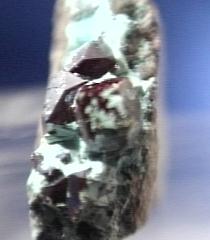
CUPRITE specimen cup-4
$ 80.00
$ 80.00
Dims: 6.75" x 2.50" x 1.25"
Wt: 11.4oz
Kolwezi, Zaire
Even though few of them are complete, the large size and high visibility of these Cuprite crystals give them great value. They are mostly partial crystals that have been broken, but several show good faces and one of them is a complete octahedron. One other crystal, however, is a complete dodecahedron in superb condition! Their color is a deep red with a slightly metallic, adamantine luster, and the crystals are clean enough on the insides to cut small gems out of. There is a large amount of these crystals for the size of the specimen compared to most Cuprites we've stocked.

cup-4 ($ 80.00)
Kolwezi, Zaire
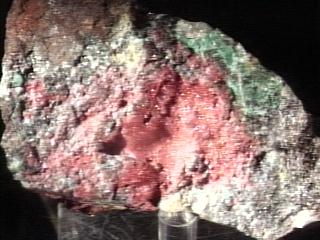
CUPRITE specimen cup-5
$ 36.00
$ 36.00
Dims: 3" x 1-3/4" x 1-5/8"
Wt: 4.8 oz
Unknown
Chalcotrichite is the name given to this crimson bed of fibers. It is a variety of Cuprite that has needle-like crystals . Though the matting is quite dense, the crystals themselves are microscopic and indistinguishable under 15x magnification. A miniscule amount of Malachite rests around the matting of Chalcotrichite, and the matrix rock is unknown, although it definitely contains some kind of Feldspar.

cup-5 ($ 36.00)
Unknown
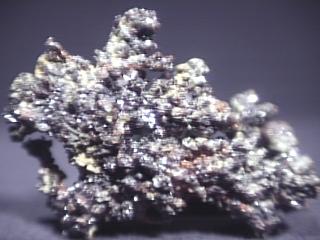
CUPRITE specimen cup-6
$ 40.00
$ 40.00
Dims: 2.3" x 1.7" x 0.9"(5.8 x 4.3 x 0.9 cm)
Wt: 1.15 oz.(32.7 g)
Ray Mine, Kearney, Arizona, U.S.A.
This specimen is a sparkling mass of arborescent native copper that is mostly coated with deep red Cuprite crystals. The crystals are tiny(less than 3 mm along an edge) and are heavily intergrown, but have cubic and dodecahedral forms that are visible under 10-power magnification. The sparkle is due to their adamantine luster, and glints of red can be seen, denoting their translucence. The native copper that is visible also shows evidence of crystalline form, with definable faces and a few tiny, warped cubes and dodecahedrons. It is a lovely little hand specimen that should be displayed upright for the best view.
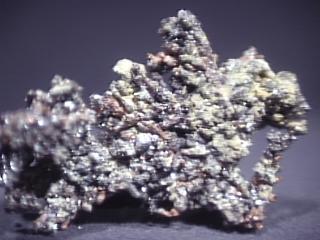

cup-6 ($ 40.00)
Ray Mine, Kearney, Arizona, U.S.A.
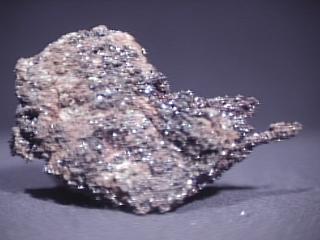
CUPRITE specimen cup-7
$ 50.00
$ 50.00
Dims: 2.9" x 2.0" x 1.2"(7.4 x 5.1 x 3.0 cm)
Wt: 3.63 oz.(103.1 g)
Ray Mine, Kearney, Arizona, U.S.A.
Almost 50% of the surface area of the dull native copper base of this specimen is covered with hundreds, if not thousands, of tiny, intergrown cubic Cuprite crystals. They all are colored the obligatory deep crimson red of Cuprite, and have an adamantine luster that makes the mass sparkle brightly. They are also translucent to transparent, as a look under 10-power magnification will prove. They cover substantial portions of the dull, weathered massive copper host, especially one edge, where the copper takes on arborescent, branching tendencies. It is a surprisingly heavy specimen, yet looks quite delicate and intricate.
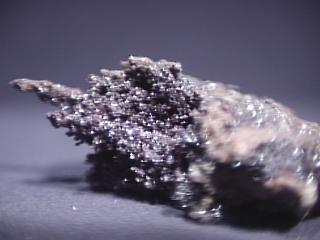

cup-7 ($ 50.00)
Ray Mine, Kearney, Arizona, U.S.A.
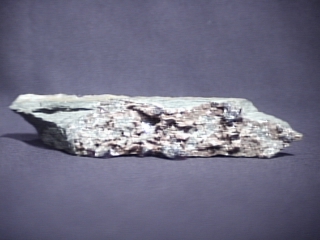
CUPRITE specimen cup-8
$ 60.00
$ 60.00
Dims: 6.7" x 2.4" x 1.3" (17.0 x 6.1 x 3.3 cm)
Wt: 11.4 oz. (322 g)
Kolwezi, Zaire
Though almost all of the 20 or so Cuprite crystals on this specimen show damage in one form or another, it still has a lot of material on it. The crystals have octahedral form and the deep red color and adamantine luster that is often associated with this mineral. The largest of the crystals is less than 50% complete, but projections of its form cause me to estimate that its original dimensions each measured approximately 0.5" (1.3 cm). The few complete crystals are limited to the smallest ones, measuring less than 0.2" (5 mm) in any dimension. They rest on what appears to be a rough gray limestone host rock.


cup-8 ($ 60.00)
Kolwezi, Zaire
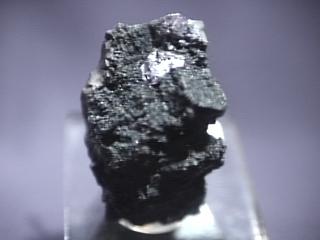
CUPRITE specimen cup-9
$ 45.00
$ 45.00
Dims: 2.9" x 1.4" x 1.2" (7.4 x 3.6 x 3.0 cm)
Wt: 2.50 oz. (70.9 g)
Cole Shaft, Bisbee, Arizona, U.S.A.
This specimen holds 3 or 4 Cuprite crystals in its goethite matrix. They are very malformed and appear to be damaged, but are actually in excellent condition, and are complete. They have an octahedral crystal form where form can be determined, and all of them have the standard deep red color and adamantine luster that one associates with Cuprite. Since the crystals are set rather deeply into the dark goethite matrix, it is difficult to determine their level of translucence, but it is dimly visible. The goethite matrix shows both a massive form with a red-gray color and dull, submetallic luster, and a botryoidal form that is black and has no luster. The specimen is hot-glued to an acrylic base.

cup-9 ($ 45.00)
Cole Shaft, Bisbee, Arizona, U.S.A.

CUPRITE specimen cup-10
$ 70.00
$ 70.00
Dims: 1.5" x 1.4" x 0.8"(3.8 x 3.6 x 2.0 cm)
Wt: 1.25 oz.(35.5 g)
Ray Mine, Kearney, Arizona, U.S.A.
This piece boasts several Cuprite crystals that are rather large with respect to the size of the entire specimen. They tend to have a warped but definable octahedral shape, and show some obvious damage, though not nearly as much as first appears. It is difficult to accurately determine the dimensions of the largest crystals due to their very warped forms and the fact that they are embedded rather deeply in the matrix; a few of the smaller crystals are quite exposed, however, and measure up to 0.3" (8 mm) in diameter. All have the standard deep red color and adamantine luster of Cuprite and are dimly translucent. They are partially embedded in a matrix rock that is made up of both hematite and what appears to be goethite. Part of the matrix shows tiny but definite crystals with a dark gray coloration. They are a bit too small for me to accurately determine their shapes, even under 10-power magnification. Other areas on the matrix show a more massive habit, while one spot in particuluar seems to have an almost compact, fibrous appearance.

cup-10 ($ 70.00)
Ray Mine, Kearney, Arizona, U.S.A.
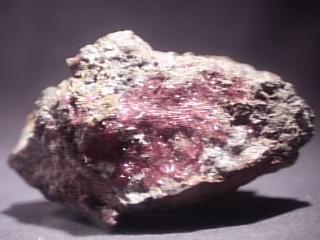
$ 420.00
Dims: 3.9" x 2.3" x 1.9" (9.9 x 5.8 x 4.8 cm)
Wt: 8.69 oz. (246.6 g)
1200 foot level, Cole Shaft, Bisbee, Cochise County, Arizona, U.S.A.
This specimen consists of a variety of Cuprite called Chalcotrichite on a rusty brown host rock. It has a finely fibrous habit, and is arranged randomly in a "thatch" on one side of the host rock. The fibers have a deep red coloration, are apparently transparent or translucent, and have a seemingly bright luster that is likely adamantine. Some of the fibers appear to be as long as 0.5" (1.3 cm), but all are thinner than human hair. There are several smaller, tighter thatches of Chalcotrichite present in small hollows in other areas on the host rock, but the largest is by far the most visible. There do not appear to be any other copper minerals present on the host rock, which I think is made up of both massive Cuprite and some limonite and/or goethite. It is a rather unusual-looking specimen that I enjoyed examining under magnification, where one can actually see the concentration of the fine fibers.
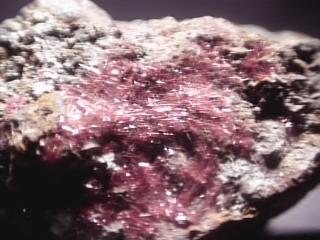

1200 foot level, Cole Shaft, Bisbee, Cochise County, Arizona, U.S.A.
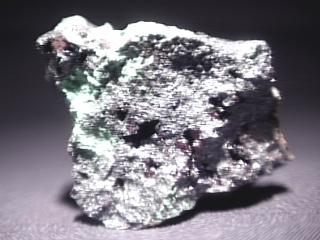
CUPRITE specimen cup-12
$ 80.00
$ 80.00
Dims: 1.6" x 1.6" x 1.4" (4.1 x 4.1 x 3.6 cm)
Wt: 4.08 oz. (115.9 g)
Bisbee, Cochise County, Arizona, U.S.A.
The aspect I like most about this specimen is that not only does it have crystals of Cuprite, but the Cuprite also acts as the "host rock" for the crystals!. It basically consists of a massive chunk of the mineral, with a small amount of pale green malachite and some rust-staining. It has many pits and hollows that are lined with crystals that are in excellent condition, but are very small (they don't exceed 0.1" (3 mm) in diameter). They occur as incomplete cubo-octahedrons and dodecahedrons that appear to be somewhat warped, likely due to intergrowth. All have smooth faces and well-defined edges, though. They have a coloration that seems to be deep red from some angles, and a metallic gray from others. Their luster is metallic, bordering on adamantine, and they are dimly translucent. The massive Cuprite is much more a gray than a red color, and is completely opaque. The pale malachite that rests on the specimen has no form whatsoever and a very dull luster.
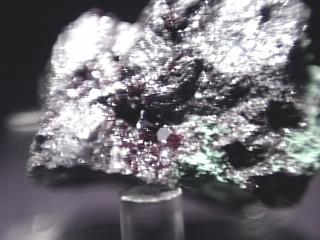

cup-12 ($ 80.00)
Bisbee, Cochise County, Arizona, U.S.A.

CUPRITE specimen cup-13
$ 115.00
$ 115.00
Dims: 4.2" x 2.7" x 2.0" (10.7 x 6.9 x 5.1 cm)
Wt: 11.4 oz. (323 g)
Mashamba Mine, Shaba, Zaire
At least 10 octahedral Cuprite crystals rest in a shallow, plancheite-lined hollow in the host rock of this specimen. They are in excellent condition, showing no human-induced damage, and range from less than 1 mm to over 0.2" (0.5 cm) in any dimension. Their form is slightly warped but very good, showing well-defined edges and smooth faces that have a bright, nearly metallic luster. Their color is a deep red, but that luster makes them appear almost gray in some instances. They show definite translucence in bright light, and one or two of the smaller crystals show transparence through light reflected off of a few small internal fractures.


cup-13 ($115.00)
Mashamba Mine, Shaba, Zaire
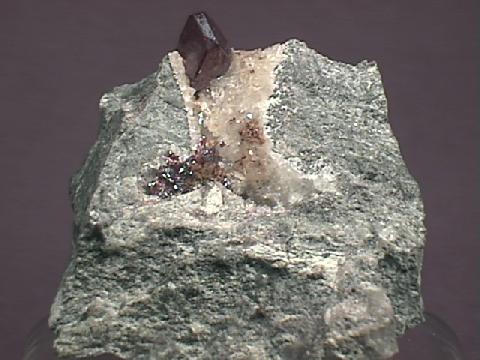
CUPRITE specimen cup-14
$ 70.00
$ 70.00
Dims: 1.6" x 1.6" x 1.0" (4.0 x 4.0 x 2.5 cm)
Wt: 1.56 oz. (44.3 g)
Mashamba Mine, Shaba Province, Zaire
This small hand specimen consists of a few incomplete Cuprite crystals that rest on a gray host rock. The most complete crystal has dimensions of 0.3 x 0.3 x 0.1" (8 x 8 x 3 mm) and appears to be only a small part of a larger crystal. I think that its original form was a complex variation on a cubo-octahedron, but there is not enough of a crystal present for me to be sure. It has the standard deep-red coloration and bright metallic-to-adamantine luster that one expects of Cuprite, and shows a dim transparence in bright light. Where intact, its crystal form is excellent, showing straight, well-defined edges and clean faces. The other bits of Cuprite rest nearby- they are heavily damaged and show no semblance of crystal form. Both rest on a thin druse of what I think is dolomite, which rests on a nondescript gray host rock.


cup-14 ($ 70.00)
Mashamba Mine, Shaba Province, Zaire
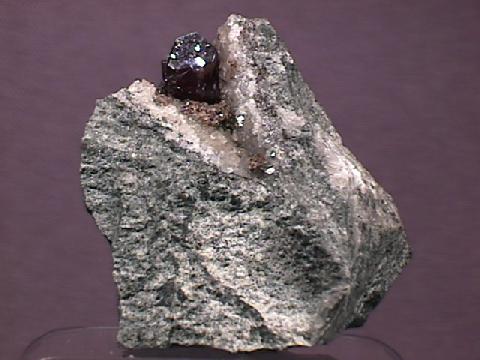
CUPRITE specimen cup-15
$ 120.00
$ 120.00
Dims: 1.6" x 1.2" x 0.7" (4.1 x 3.0 x 1.8 cm)
Wt: 1.75 oz. (49.6 g)
Mashamba Mine, Shaba Province, Zaire
This small specimen consists of a cluster of at least 3 intergrown Cuprite octahedrons, most of which are incomplete. The largest of these crystals measures 0.3 x 0.2 x 0.2" (0.8 x 0.5 x 0.5 cm) and is only about half complete due to a large and rather clean break that likely occurred when the specimen was separated from its host rock. Like its intergrown partners, it has very good form, with straight edges and clean faces that possess an adamantine luster that is almost metallic. All have a very deep red coloration and are transparent and quite clear, though their color is so deep that their clarity can only be determined in a bright light. The crystals rest in a small calcite- or dolomite-lined crevice in the limestone host rock.
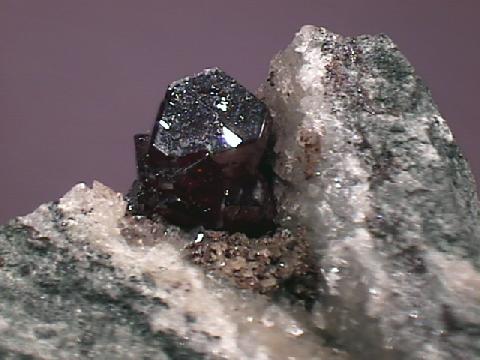

cup-15 ($120.00)
Mashamba Mine, Shaba Province, Zaire
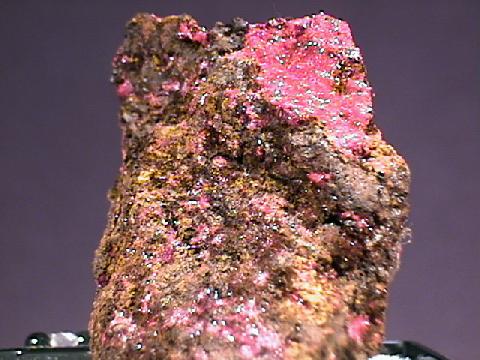
CUPRITE specimen cup-16
$ 60.00
$ 60.00
Dims: 1.9" x 1.5" x 0.8" (4.8 x 3.8 x 2.0 cm)
Wt: 2.23 oz. (63.3 g) w/ specimen box
Sandy Flat Pipe, Red Bank, Northern Territories, Australia
The goethite/limonite host of this specimen is partly covered by many small mattings of intergrown Cuprite crystals. These crystals occur in a finely fibrous form known as Chalcotrichite. Due to their fibrous form and interwoven nature, it is difficult to determine the maximum length of and the extent of damage to the crystals. They have a deep red coloration and show a bright, almost adamantine luster that gives the mattings a silky visual texture. I would imagine that each individual crystal is transparent and quite clear, though one would need powerful magnification to acutally see these qualities. There is one particularly large matting on the specimen that is easy to see; the others are quite small, not exceeding 0.2" (5 mm) in width or length. The piece is affixed inside a plastic specimen box with an adhesive putty.
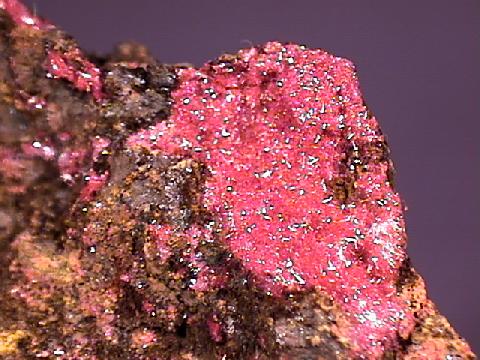

cup-16 ($ 60.00)
Sandy Flat Pipe, Red Bank, Northern Territories, Australia
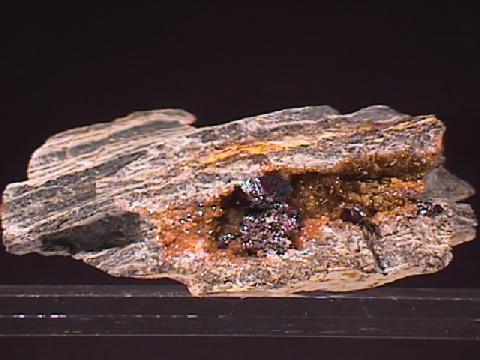
CUPRITE specimen cup-18
$ 25.00
$ 25.00
Dims: 3.6 x 2.7 x 1.3" (9.1 x 6.9 x 3.3 cm)
Wt: 8.25 oz. (233.8 g)
Kolwezi, Zaire
At least 5 discernable Cuprite crystals rest on the banded gray host rock of this hand specimen. The largest of these crystals are quite intergrown, but appear to measure no more than 0.3" (8 mm) in diameter. A few are heavily damaged, some are incomplete due to restricted growing space, and a few of them are complete and undamaged. All have the octahedral form that is standard for Cuprite and where intact have well-defined edges and clean faces that possess the obligatory adamantine luster. Their red coloration is so deep that even the smallest crystals show only a moderate to dim translucence under halogen light. The Cuprites rest on a thin druse of tiny crystals that are either made up of rusty calcite or possibly ankerite. Several badly broken and mostly incomplete Cuprite crystals rest on the other side of the gray host rock, but there is not much left of them.
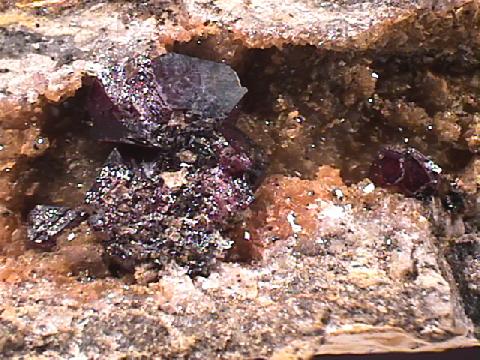

cup-18 ($ 25.00)
Kolwezi, Zaire
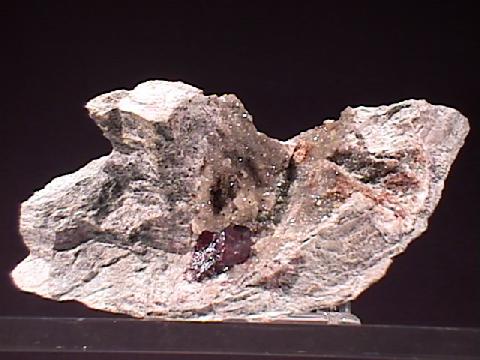
CUPRITE specimen cup-19
$ 45.00
$ 45.00
Dims: 4.2 x 2.1 x 1.9" (10.7 x 5.3 x 4.8 cm)
Wt: 6.45 oz. (182.8 g)
Kolwezi, Zaire
At least 4 intergrown Cuprite crystals rest on the pale host rock of this hand specimen. Though none of the crystals are complete due to their intergrowth, the two largest ones are broken, and one of those is mostly incomplete. The other has visible dimensions of 0.3 x 0.3 x 0.2" (8 x 8 x 5 mm) and is over 50% complete. Where intact, the crystals have excellent octahedral form, with well-defined edges and clean faces. They have the classic deep red-gray coloration and adamantine, submetallic luster, and are opaque under normal light. The host rock surrounding the Cuprites is coated with a thin druse of what appears to be quartz, though it has a rather dull, pearly luster.
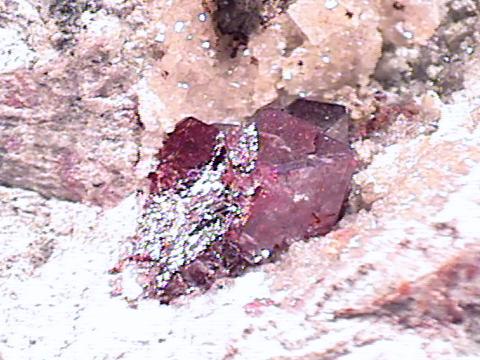

cup-19 ($ 45.00)
Kolwezi, Zaire
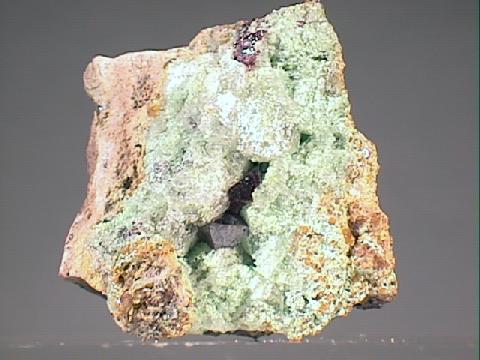
CUPRITE specimen cup-20
$ 35.00
$ 35.00
Dims: 1.4 x 1.4 x 0.9" (3.7 x 3.6 x 2.3 cm)
Wt: 28.1 g
Mashamba Mine, Shaba Province, Zaire
Two small Cuprite octahedrons rest on the shale base of this small hand specimen. These crystals do not measure more than 0.1" (3 mm) along any edge, but are in excellent condition and have excellent form. Both have a deep red coloration and an adamantine luster that is nearly metallic. A small portion of a broken crystal lies elsewhere on the malachite/calcite layer that separates the Cuprites from the host rock.

cup-20 ($ 35.00)
Mashamba Mine, Shaba Province, Zaire
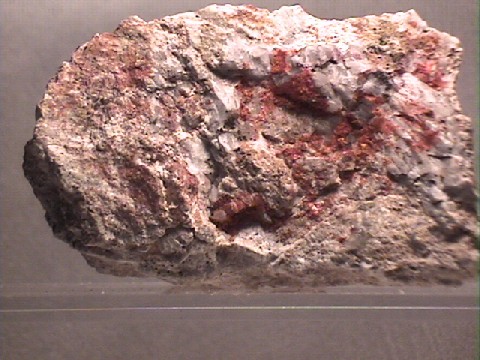
CUPRITE specimen cup-21
$ 60.00
$ 60.00
Dims: 4.0 x 2.9 x 2.4" (10.2 x 7.4 x 6.0 cm)
Wt: 14.7 oz. (417 g)
Bagdad, Arizona, U.S.A.
Countless tiny Chalcotrichite needles are matted together on the brown calcareous base of this cabinet specimen. These needles do not exceed 2 mm in length and are too tiny to study even with a loupe - they likely have reasonably good form, however. All have the standard deep red color and the mats of crystals show a silky luster.
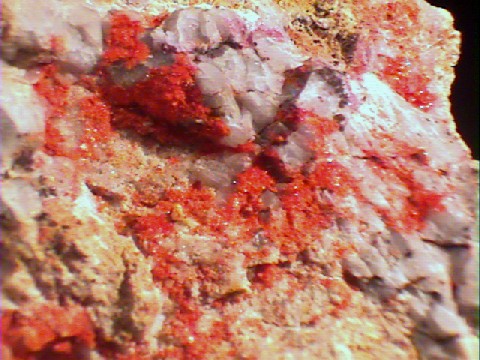

cup-21 ($ 60.00)
Bagdad, Arizona, U.S.A.
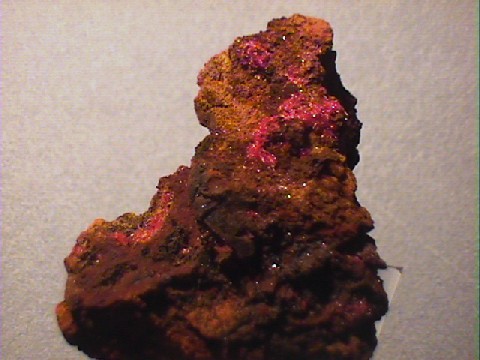
CUPRITE specimen cup-22
$ 30.00
$ 30.00
Dims: 3.1 x 2.4 x 1.7" (8.0 x 6.0 x 4.3 cm)
Wt: 3.6 oz. (103 g)
Sandy Flat Pipe, Redbank Mine, Wollogorang Station, Northern Territory, Australia
Several mattes of Chalcotrichite, the fibrous variety of Cuprite, rest on the rusty base rock of this cabinet piece. These mattes are each made up of countless intertwined and matted Chalcotrichite needles that do not exceed 0.1" (3 mm) in length and are far too fine to study even with a 10-power loupe. All have the standard deep red color of the specie and give the mattes an adamantine sparkle. They are transparent and quite clear.

cup-22 ($ 30.00)
Sandy Flat Pipe, Redbank Mine, Wollogorang Station, Northern Territory, Australia
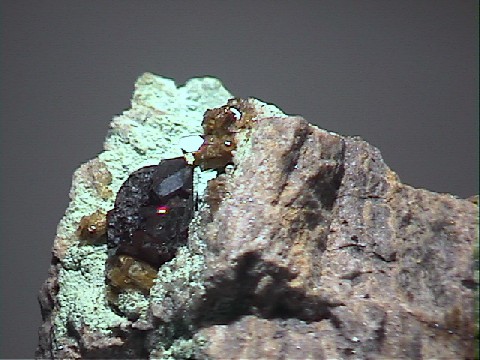
CUPRITE specimen cup-23
$ 200.00
$ 200.00
Dims: 2.6 x 2.4 x 1.7 " (6.8 x 5.8 x 4.5 cm)
Wt: 6.35 oz (180.2 g)
Mashamba Mine, Shaba, Zaire
This hand specimen exhibits a large cuprite crystal against a crust of green plancheite. The cuprite has excellent red fire when illuminated and viewed properly. This is also the easiest way to identify the myriad other tiny cuprite crystals in or on the host matrix - they, too, show an intense red flash from certain angles. There are also crystals of a pale yellow transparent mineral which looks like barite, but I cannot be sure.


cup-23 ($200.00)
Mashamba Mine, Shaba, Zaire
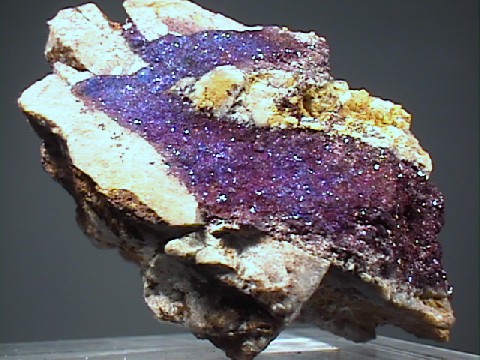
CUPRITE specimen cup-24
$ 65.00
$ 65.00
Dims: 1.9x1.4x1.2" (5.0x3.6x3.0 cm)
Wt: 2.44 oz. (69.0g)
Bisbee, Cochise County, Arizona, USA
This specimen has a thick vein of massive bornite which is covered with a druze of tiny but colorful cuprite crystals. Under a loupe, the cuprite crystals are red and transparent, excellent crystals. In much of the vein, the bornite shows through, lending a purple hue to the specimen, which deepens to violet in places. The largest of the cuprite crystals show an excellent cubic form, and are very transparent with a red fire.
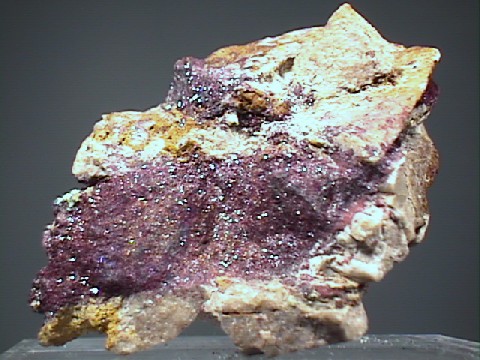

cup-24 ($ 65.00)
Bisbee, Cochise County, Arizona, USA
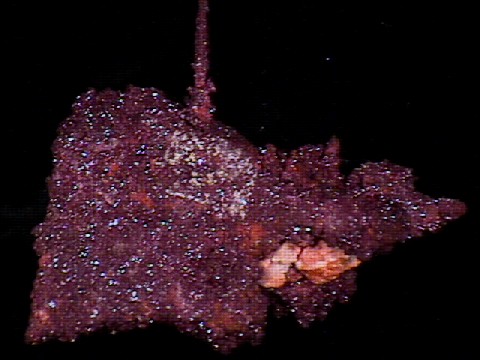
CUPRITE specimen cup-25
$ 75.00
$ 75.00
Dims: 2.5x2.0x0.9" (6.4x5.0x2.4cm)
Wt: 3.34 oz. (94.4g)
Ray Mine, Pinal Co., Arizona, USA
An odlyshaped specimen of native copper (with a spire and several other protrusios) has been entirely coated with a druze of cuprite crystals. These sparkle brightly, and in all of the protected crevices the tiny curpite crystals are transparent and well formed. Some cubic crystals are nearly a millimeter on a side, and some of them are transparent and large enough to show a deep red fire.
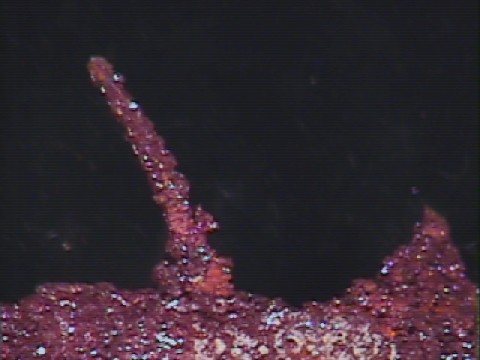

cup-25 ($ 75.00)
Ray Mine, Pinal Co., Arizona, USA

CUPRITE specimen cup-26
$ 40.00
$ 40.00
Dims: 2.80x2.01x1.69" )7.1x5.1x4.3cm)
Wt: 6.03 oz (170.6g)
Bisbee, Cochise County, Arizona, USA
This multi-colored and complexly shaped rock hosts several crystalline crusts of cuprite crystals. Their color varies from maroon to a brownish-red. At first glance, the cuprite crystals appear to be millimeter size, judging by the reflections of bright lights. Examination with a loupe reveals that these crystals are clusters of very tiny crystals (a very bumpy surface), but their terminations match on a millimeter scale, such that the entire cluster reflects light at the same angle. This specimen is host to at least 6 other minerals which I cannot identify (except for some limonite).
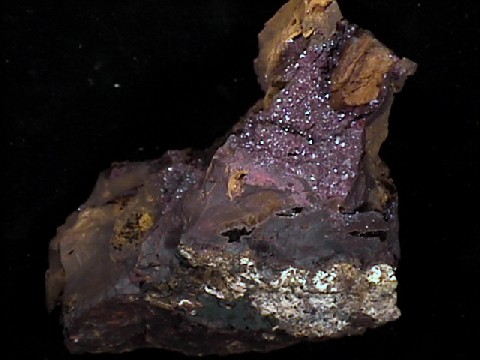

cup-26 ($ 40.00)
Bisbee, Cochise County, Arizona, USA

CUPRITE specimen cup-33
$ 25.00
$ 25.00
Dims mm=21.3x9.6x5.3
Wt g=1.5g
Arizona, USA
This specimen is covered on most surfaces with a mat of acicular cuprite crystals. This form is also known as chalcotrichite.


cup-33 ($ 25.00)
Arizona, USA